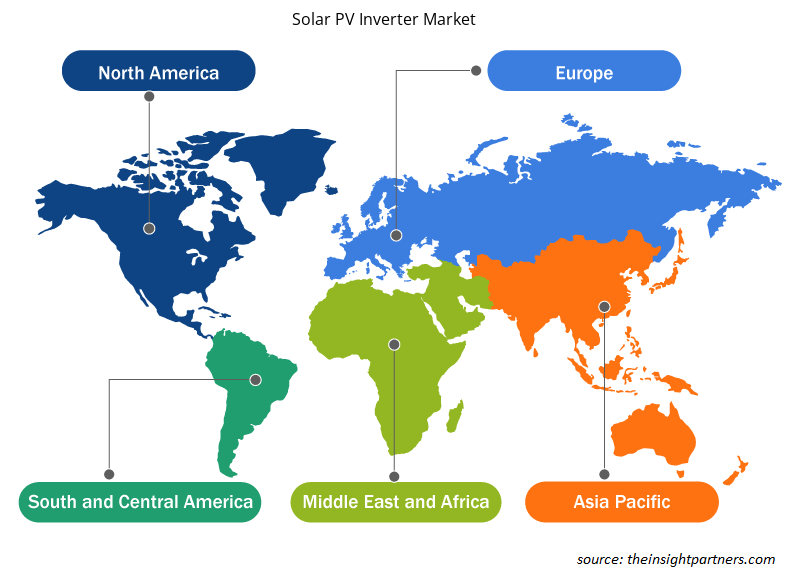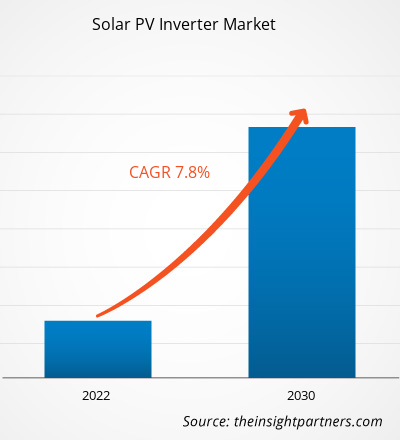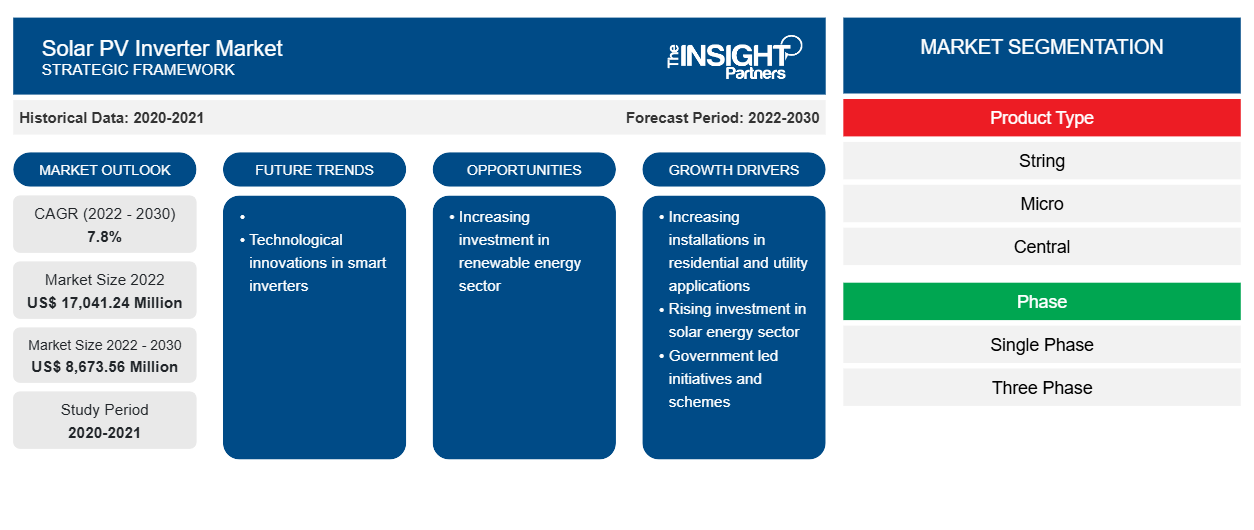태양광 PV 인버터 시장 규모는 2022년 17,041.24백만 달러에서 2030년까지 8,673.56백만 달러로 성장할 것으로 예상됩니다. 이 시장은 2022~2030년에 7.8%의 CAGR을 기록할 것으로 예상됩니다. 태양광 에너지 부문에 대한 빠른 투자, 태양광 인버터의 기술적 진보 또는 개발, 유틸리티 기반 태양광 발전소 설치 증가는 태양광 PV 인버터 시장을 주도하는 주요 요인 중 하나입니다.
태양광 PV 인버터 시장 분석
태양광 PV 인버터 시장은 분석 기간 동안 태양광 에너지 프로젝트 수의 증가와 고급 태양광 PV 인버터 솔루션의 발견으로 인해 상당한 성장을 경험할 것으로 예상됩니다. 또한 스마트 태양광 PV 인버터는 자율적인 결정을 내려 전력망을 안정적이고 신뢰할 수 있게 유지할 수 있는 기술적으로 진보된 유형의 전력 전자 장치입니다. 스마트 태양광 인버터는 전압 변동 없이 중단 없는 전기 흐름을 보장하면서 작동합니다. 전압 및 주파수 센서를 포함한 고급 기능을 통해 스마트 태양광 인버터는 그리드 이상을 감지하고 유틸리티 운영자에게 피드백을 보낼 수 있습니다. 또한 스마트 태양광 인버터는 전력 유틸리티 제어 센터와 양방향 통신을 보장하여 주거 및 상업용 애플리케이션에서 효율성을 향상시키고, 이는 향후 몇 년 동안 시장 성장을 견인할 것으로 예상됩니다.
태양광 PV 인버터 시장 개요
정부 주도의 인센티브와 제도에 기인한 전 세계의 태양광 설비와 주거용 태양광 옥상 설비의 증가는 태양광 PV 인버터 시장 성장에 긍정적인 영향을 미칩니다. 또한 화석 연료 소비를 줄여 탄소 배출을 줄이기 위한 재생 에너지 부문에 대한 투자 증가와 태양광 인버터의 기술 혁신이 시장 성장을 견인하는 요인 중 하나입니다. 그러나 태양광 인버터의 높은 DC 전압과 관련된 위험은 시장 성장을 제한하고 있습니다. 전 세계 정부는 태양광을 주요 에너지원으로 사용하도록 장려하기 위해 다양한 제도를 시작하고 있습니다. 태양광 옥상 시스템을 설치하면 사람들이 전기를 생산하고 주거, 상업, 심지어 산업을 포함한 다양한 용도로 활용할 수 있습니다.
귀하의 요구 사항에 맞게 이 보고서를 사용자 정의하세요
이 보고서의 일부 또는 국가 수준 분석, Excel 데이터 팩을 포함하여 모든 보고서에 대한 사용자 정의를 무료로 받을 수 있으며 신생 기업 및 대학을 위한 훌륭한 혜택과 할인 혜택을 이용할 수 있습니다.
-
이 보고서의 주요 시장 동향을 알아보세요.이 무료 샘플에는 시장 동향부터 추정 및 예측까지 다양한 데이터 분석이 포함됩니다.
태양광 PV 인버터 시장 동인 및 기회
주거 및 공공 서비스 분야에서 설치가 늘어나는 것이 태양광 PV 인버터 시장을 이끄는 주요 원동력이 될 것으로 예상됩니다.
지속 가능성과 에너지 안보를 달성하기 위한 녹색 전기에 대한 추구가 증가하는 수요를 충족하고 화석 연료 기반 발전원을 대체하기 위해 태양광 PV를 배치하는 주요 요인입니다. 이러한 성장은 주로 정부 이니셔티브와 인센티브 증가, 기술 발전, 지속적인 비용 절감 및 농촌 지역의 전기화 때문입니다. 주거용 태양광 지붕 시스템은 설치하기 쉽고 최소한의 유지 관리가 필요합니다. 생성된 초과 전력은 순계량 측정 시설을 통해 전력망에 판매되어 전기 요금을 줄이는 데 도움이 됩니다. 화석 연료 매장량 고갈, 환경 악화 가속화 및 발전 인프라에 대한 압박을 감안하여 여러 정부가 주거용 태양 광 솔루션을 제공하여 태양광 에너지 채택을 강화하기 위한 보조금 또는 인센티브를 제공했습니다.
태양열 에너지 부문에 대한 투자 모금
국제 에너지 기구(IEA)에 따르면, 2022년 세계 전력 수요는 8% 증가할 것으로 예상됩니다. 2022년 투자 증가는 회복에 대한 순환적 반응과 더 깨끗한 기술로의 자본 흐름의 구조적 변화가 섞인 것입니다. 최근 투자 중 일부는 다음과 같습니다.
- 유럽 태양광 기구에 따르면 이 지역은 2022년에 41.4GW의 태양광 발전소를 설치했으며, 2021년에는 47% 증가할 것으로 예상됩니다.
- 사우디 아라비아 정부는 2023년 1월에 전국의 청정 에너지 개발을 위해 2,260억 달러를 투자한다고 발표했습니다. 이 투자는 전국의 수요를 충족시키기 위해 전력을 생산하기 위한 풍력 및 태양광 에너지 인프라를 개발하는 데 사용될 것입니다.
- 중국 국가에너지국은 2022년에 106기가와트(GW) 규모의 태양광 인프라를 설치해 전년 대비 100% 성장을 보일 것으로 전망했습니다.
따라서 재생 에너지 부문에 대한 투자 증가는 예측 기간 동안 태양광(PV) 인버터 시장 참여자들에게 기회를 창출하는 데 도움이 됩니다.
태양광 PV 인버터 시장 보고서 세분화 분석
태양광 PV 인버터 시장 분석에 기여한 주요 세그먼트는 제품 유형, 단계, 연결성, 애플리케이션 및 용량입니다.
- 제품 유형에 따라 태양광 PV 인버터 시장은 스트링, 마이크로, 센트럴로 구분되었습니다. 센트럴 세그먼트는 2022년에 더 큰 시장 점유율을 차지했습니다.
- 태양광 PV 인버터 시장은 위상에 따라 단상과 3상으로 구분되었습니다. 3상 세그먼트는 2022년에 더 큰 시장 점유율을 차지했습니다.
- 연결성을 기준으로 시장은 독립형과 온그리드로 세분화되었습니다. 온그리드 세그먼트는 2022년에 시장을 지배했습니다.
- 응용 프로그램을 기준으로 태양광 PV 인버터 시장은 주거 및 커뮤니티, 상업 및 산업, 유틸리티로 구분되었습니다. 유틸리티 부문은 2022년에 더 큰 시장 점유율을 차지했습니다.
- 용량에 따라 태양광 PV 인버터 시장은 5kW 미만, 5~15kW, 15~25kW, 25~50kW, 50kW 이상으로 구분되었습니다. 50kW 이상 세그먼트는 2022년에 더 큰 시장 점유율을 차지했습니다.
지역별 태양광 PV 인버터 시장 점유율 분석
태양광 PV 인버터 시장 보고서의 지리적 범위는 주로 북미, 유럽, 아시아 태평양, 중동 및 아프리카, 남미의 5개 지역으로 나뉩니다.
아시아 태평양 지역은 2022년에 태양광 PV 인버터 시장을 지배할 것입니다. 아시아 태평양 지역에는 호주, 중국, 인도, 한국, 일본 및 아시아 태평양의 나머지 지역이 포함됩니다. 아시아 태평양 지역에서 태양광 PV 인버터 시장 성장은 기후 변화와 순 제로 배출 목표에 대한 정부 전략 및 이니셔티브 증가로 인한 재생 에너지 산업의 상당한 발전 덕분입니다. 태양광 발전(PV) 플랜트에 대한 투자 증가와 중국, 인도, 호주, 일본과 같은 아시아 태평양 국가의 주거 부문에서 태양광 발전소 설립의 성장은 태양광 인버터 시장 참여자에게 수익성 있는 기회를 창출하고 있습니다. 중국에서는 대부분 PV 제품 또는 태양광 패널이 거대한 태양광 농장의 외딴 지역에 설치되어 생산된 에너지를 유틸리티에 판매합니다. 위성 이미지는 중국 전역의 이러한 대규모 태양광 농장의 증가를 보여줍니다. 이 나라의 태양광 에너지가 급격히 증가한 것은 국가의 전기 수요와 심각한 대기 오염 위기 때문입니다. 중국 정부는 금융 기관이 태양광 설비에 대한 인센티브를 제공하도록 장려하는 것을 목표로 합니다.
태양광 PV 인버터 시장 지역 통찰력
Insight Partners의 분석가들은 예측 기간 동안 태양광 PV 인버터 시장에 영향을 미치는 지역적 추세와 요인을 철저히 설명했습니다. 이 섹션에서는 북미, 유럽, 아시아 태평양, 중동 및 아프리카, 남미 및 중미의 태양광 PV 인버터 시장 세그먼트와 지리에 대해서도 설명합니다.

- 태양광 PV 인버터 시장에 대한 지역별 데이터 얻기
태양광 PV 인버터 시장 보고서 범위
| 보고서 속성 | 세부 |
|---|---|
| 2022년 시장 규모 | 17,041.24백만 달러 |
| 2030년까지 시장 규모 | 8,673.56백만 달러 |
| 글로벌 CAGR (2022-2030) | 7.8% |
| 역사적 데이터 | 2020-2021 |
| 예측 기간 | 2022-2030 |
| 다루는 세그먼트 |
제품 유형별
|
| 포함된 지역 및 국가 |
북아메리카
|
| 시장 선도 기업 및 주요 회사 프로필 |
|
태양광 PV 인버터 시장 참여자 밀도: 비즈니스 역학에 미치는 영향 이해
태양광 PV 인버터 시장 시장은 소비자 선호도의 변화, 기술 발전, 제품의 이점에 대한 인식 증가와 같은 요인으로 인해 최종 사용자 수요가 증가함에 따라 빠르게 성장하고 있습니다. 수요가 증가함에 따라 기업은 제품을 확장하고, 소비자의 요구를 충족하기 위해 혁신하고, 새로운 트렌드를 활용하여 시장 성장을 더욱 촉진하고 있습니다.
시장 참여자 밀도는 특정 시장이나 산업 내에서 운영되는 회사나 기업의 분포를 말합니다. 주어진 시장 공간에 얼마나 많은 경쟁자(시장 참여자)가 존재하는지 그 규모나 전체 시장 가치에 비해 나타냅니다.
태양광 PV 인버터 시장에서 운영되는 주요 회사는 다음과 같습니다.
- 델타 일렉트로닉스 주식회사
- 피메르 스파
- FRONIUS 인터내셔널 GmbH
- 진롱 테크놀로지스
- 화웨이 테크놀로지스 주식회사
- SMA Solar Technology AG
면책 조항 : 위에 나열된 회사는 어떤 특별한 순서에 따라 순위가 매겨지지 않았습니다.

- 태양광 PV 인버터 시장 주요 업체 개요를 알아보세요
태양광 PV 인버터 시장 뉴스 및 최근 개발
태양광 PV 인버터 시장은 1차 및 2차 조사 이후의 정성적, 정량적 데이터를 수집하여 평가합니다. 여기에는 중요한 기업 간행물, 협회 데이터 및 데이터베이스가 포함됩니다. 다음은 태양광 PV 인버터 시장과 전략에 대한 시장의 개발 목록입니다.
- 2023년 2월, SolarEdge Technologies Inc.는 미국 주거용 태양광 설치 회사인 Freedom Forever와 다년 계약을 체결했습니다. 이 계약은 주거용 스마트 에너지 제품 및 솔루션을 공급하는 것을 목표로 했습니다. 두 회사 간의 이 다년 계약을 통해 Freedom Forever는 Home Hub Inverter, Power Optimizers, Home Battery, Backup Interface, SolarEdge EV Charger 및 Load Controllers와 같은 스마트 에너지 장치를 포함한 SolarEdge Home Smart Energy Ecosystem의 제품을 제공할 것입니다.
- 2022년 4월, SMA는 12, 15, 20, 25kW의 전력 정격을 가진 4개의 인버터를 추가하여 제품 라인을 확장했습니다. 최대 135kW 크기의 옥상 애플리케이션에 사용됩니다.
태양광 PV 인버터 시장 보고서 범위 및 제공물
"태양광 PV 인버터 시장 규모 및 예측(2020-2030)" 보고서는 아래 영역을 포괄하는 시장에 대한 자세한 분석을 제공합니다.
- 범위에 포함된 모든 주요 시장 세그먼트에 대한 글로벌, 지역 및 국가 수준의 시장 규모 및 예측
- 동인, 제약 및 주요 기회와 같은 시장 역학
- 주요 미래 트렌드
- 포터의 5가지 힘에 대한 자세한 분석
- 주요 시장 동향, 주요 업체, 규정 및 최근 시장 동향을 포괄하는 글로벌 및 지역 시장 분석
- 시장 집중도, 히트맵 분석, 유명 기업 및 최근 개발 사항을 포함하는 산업 환경 및 경쟁 분석
- SWOT 분석을 통한 자세한 회사 프로필
- 과거 분석(2년), 기준 연도, CAGR을 포함한 예측(7년)
- PEST 및 SWOT 분석
- 시장 규모 가치/거래량 - 글로벌, 지역, 국가
- 산업 및 경쟁 환경
- Excel 데이터세트
최근 보고서
관련 보고서
사용 후기
구매 이유
- 정보에 기반한 의사 결정
- 시장 역학 이해
- 경쟁 분석
- 고객 인사이트
- 시장 예측
- 위험 완화
- 전략 기획
- 투자 타당성 분석
- 신흥 시장 파악
- 마케팅 전략 강화
- 운영 효율성 향상
- 규제 동향에 발맞춰 대응























 무료 샘플 받기 - 태양광 PV 인버터 시장
무료 샘플 받기 - 태양광 PV 인버터 시장